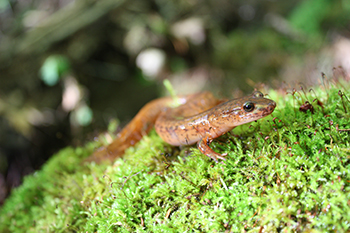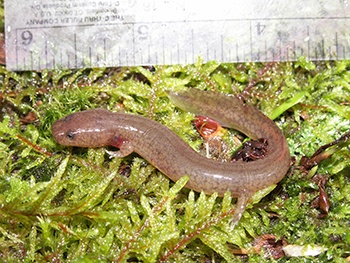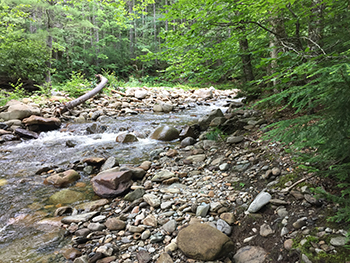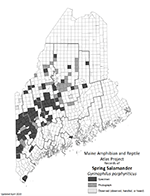Home → Fish & Wildlife → Wildlife → Species Information → Reptiles & Amphibians → Spring Salamander
Spring Salamander
Gyrinophilus porphyriticus
On this page:

Photo: Trevor Persons
Distinguishing Characteristics

Photo: Trevor Persons
- Stocky, medium to large salamander, approximately 4.5 to 7.5 inches in length
- Bright salmon-pinkish-orange in color with faint small dark spots, the underside is a pale tan
- Light line extends from the eye to nostril
- Tail has ridge along top to aid salamander in swimming
Status and Distribution in Maine
- State Special Concern; Species of Greatest Conservation Need
- Uncommon
- Western and central regions
Habitat

Photo: Trevor Persons
- Cold, clear, rocky streams with gravelly substrates
- Deciduous forest or deciduous-dominated mixed forest
Diet
- Eats other, smaller salamanders (northern dusky, northern two-lined), as well as invertebrates
Seasonal Changes
- Overwinter in or near running water of streams, springs, and seeps. May be active year-round underground in streams
Natural History Notes
- Highly aquatic, one of three species of "brook" or "stream" salamanders in Maine
Share Your Sighting
There is much still to learn about the distribution and ecology of Maine’s herpetofauna, and we encourage members of the public to share their photo-documented observations as part of the Maine Amphibian & Reptile Atlas Project (MARAP).
To see if a township still needs documentation of a species, consult this distribution map (PDF). If a township lacks a photo or specimen record, we want your observation!
There are two ways to share your observations:
Submit your reptile or amphibian observation online
No service? No problem. Click here to download the survey to your device while connected, then take offline to collect observations from anywhere. Tip: The survey works best on Google Chrome and Safari.
Or upload sightings to the iNaturalist citizen science project through their website at iNaturalist.org or mobile app.
- When submitting an observation through iNaturalist add a description of the location (and other noteworthy information) to the “notes” field. This serves as a check on the locations automatically generated by smartphone cameras, which may be imprecise if cell service or GPS coverage is weak.
Thank you for doing your part to help conserve Maine’s reptiles and amphibians.
